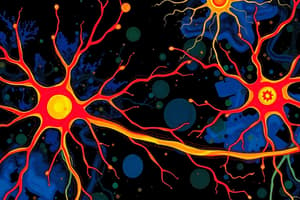Podcast
Questions and Answers
The brain and spinal cord make up which division of the nervous system?
The brain and spinal cord make up which division of the nervous system?
central nervous system
The motor neurons which direct muscle movement make up which division of the nervous system?
The motor neurons which direct muscle movement make up which division of the nervous system?
motor division
The 'fight or flight' sympathetic nervous system is half of which division of the nervous system?
The 'fight or flight' sympathetic nervous system is half of which division of the nervous system?
autonomic nervous system
Which of the following types of glial cells line the fluid-filled central cavities of the brain and spinal cord?
Which of the following types of glial cells line the fluid-filled central cavities of the brain and spinal cord?
Which of the following types of glial cells are most abundant?
Which of the following types of glial cells are most abundant?
Which of the following statements about neurons is true?
Which of the following statements about neurons is true?
Which of the following structures in neurons are the primary input region?
Which of the following structures in neurons are the primary input region?
Neurons can be classified structurally by the number of processes extending from their cell body; what is this classification for neurons with multiple processes?
Neurons can be classified structurally by the number of processes extending from their cell body; what is this classification for neurons with multiple processes?
A neuron has a membrane potential of -70. Is this within the normal resting potential range?
A neuron has a membrane potential of -70. Is this within the normal resting potential range?
During which phase of the generation of an action potential are the voltage-gated Na channels open and K channels closed?
During which phase of the generation of an action potential are the voltage-gated Na channels open and K channels closed?
Which of the following statements about hyperpolarization is true?
Which of the following statements about hyperpolarization is true?
Which of the following factors contributes to increased conduction velocity?
Which of the following factors contributes to increased conduction velocity?
Which of the following substances is not one of the transmitters discussed in class?
Which of the following substances is not one of the transmitters discussed in class?
Which of the following neurotransmitters is a naturally occurring opiate within the human body?
Which of the following neurotransmitters is a naturally occurring opiate within the human body?
In an axosomatic synapse, where is the meeting point in the postsynaptic neuron?
In an axosomatic synapse, where is the meeting point in the postsynaptic neuron?
The sodium-potassium pump re-establishes the correct ion distribution after an action potential; what is being moved where?
The sodium-potassium pump re-establishes the correct ion distribution after an action potential; what is being moved where?
Which of the following statements about action potentials is true?
Which of the following statements about action potentials is true?
Which ion is released in the axon terminal with an incoming action potential and causes the release of neurotransmitters from the synaptic vesicles?
Which ion is released in the axon terminal with an incoming action potential and causes the release of neurotransmitters from the synaptic vesicles?
Flashcards are hidden until you start studying
Study Notes
Nervous System Divisions
- The brain and spinal cord compose the central nervous system (CNS).
- Motor division refers to motor neurons that direct muscle function.
- The autonomic nervous system includes the sympathetic nervous system, known for the "fight or flight" response.
Glial Cells
- Ependymal cells line the fluid-filled central cavities of the brain and spinal cord.
- Astrocytes are the most abundant type of glial cells.
Neurons
- Neurons can function optimally under normal conditions.
- Dendrites are the primary input regions of neurons.
- Neurons are classified structurally; multipolar is one classification based on the number of processes extending.
Neuron Action Potentials
- A neuron with a membrane potential of -70 mV is within the normal resting potential range.
- During depolarization, voltage-gated sodium channels open while potassium channels remain closed.
- In a hyperpolarized state, there are significantly more potassium ions outside the cell.
Conduction Velocity
- The presence of a myelin sheath contributes to increased conduction velocity in neurons.
Neurotransmitters
- Acetylcholinesterase is not one of the neurotransmitters discussed in this context.
- Endorphins are naturally occurring opiates produced within the human body.
Synapses and Action Potentials
- In an axosomatic synapse, the meeting point between neurons is at the dendrites of the postsynaptic neuron.
- The sodium-potassium pump restores ion distribution post-action potential by moving 3 sodium ions out for every 2 potassium ions in.
- Action potentials are generated in the dendrites and cell body of neurons.
- Calcium ions are released at the axon terminal during an incoming action potential, facilitating the release of neurotransmitters from synaptic vesicles.
Studying That Suits You
Use AI to generate personalized quizzes and flashcards to suit your learning preferences.



